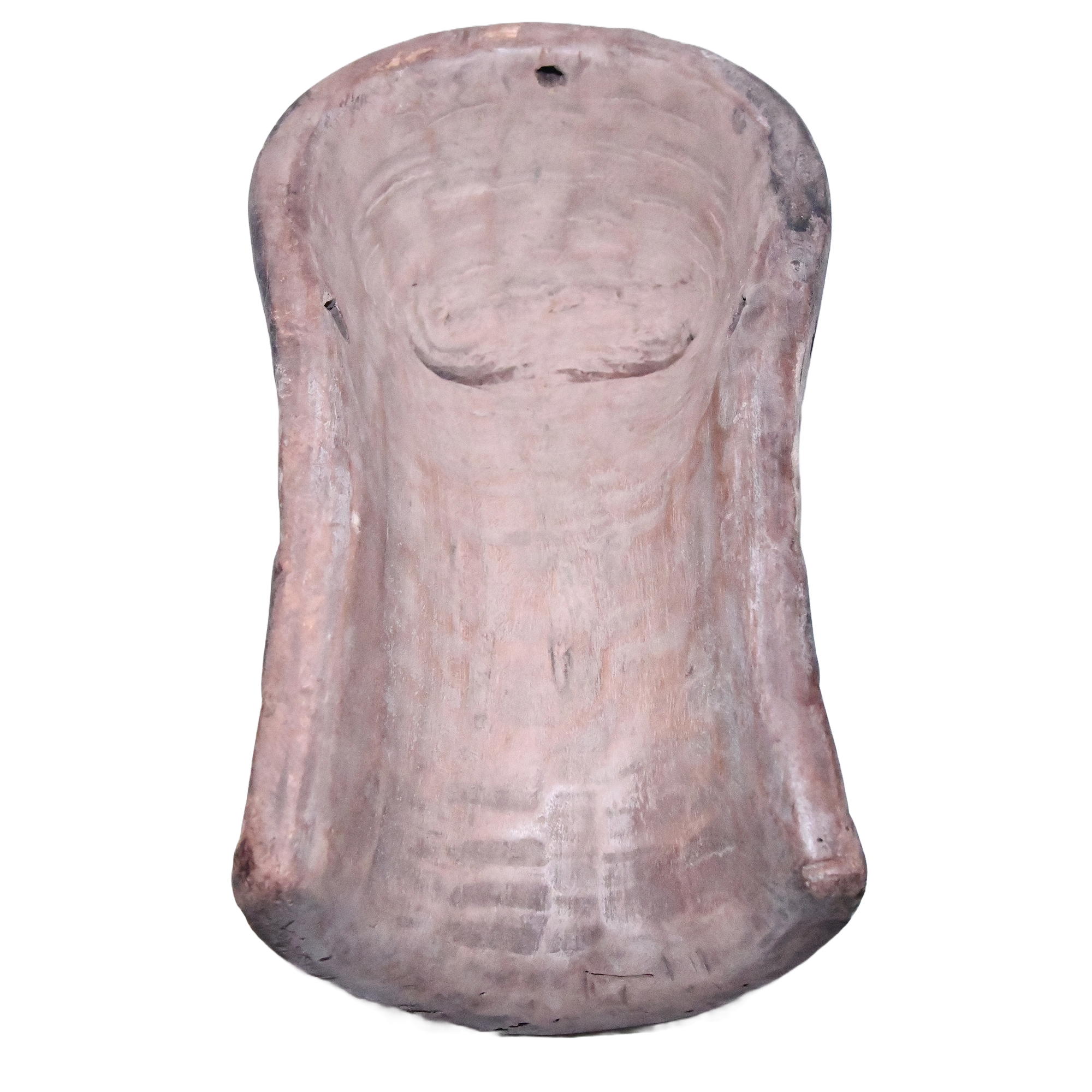African Songye Kifwebe Mask
Songye Kifwebe Mask
Date: early to mid 20th century
Geography: Democratic Republic of Congo,
Culture: Songye people
Dimensions: 33cm L x 18cm W x 12cm D.
Weight 769g
Material: wood
Condition is used for its age, has some wear on the pigment
Alt text: Songye Kifwebe mask, a wooden mask with a stylized human face, often used in ceremonies and rituals.
The Songye Kifwebe Mask, originating from the Songye people of the Democratic Republic of Congo, is a striking and symbolic form of African tribal art. Carved from wood, these masks are characterised by bold geometric patterns, prominent crests, and contrasting colours, typically featuring a combination of red, black, and white.
"Kifwebe" translates to "mask" in the Songye language, and these masks serve multifaceted roles within Songye society. They are often associated with rites of passage, social control, and ceremonies related to governance and justice. The masks are divided into two main types: male and female. The male mask, characterised by a linear pattern and a large crest, represents authority, strength, and social order. Meanwhile, the female mask, distinguished by a more rounded form and subtle detailing, signifies fertility and nurturing qualities.
The history of the Songye Kifwebe Mask dates back to the early 20th century, with the emergence of secret societies such as the Bwadi Bwa Kifwebe. These societies utilised masks during initiation rituals and community events, reinforcing social structures and spiritual beliefs. Over time, the Kifwebe Mask has become a symbol of cultural identity and spiritual connection for the Songye people, with the distinctive design elements reflecting their cosmology and worldview. Today, these masks are not only revered as artistic masterpieces but also as potent symbols of Songye cultural heritage.
Songye Kifwebe Mask
Date: early to mid 20th century
Geography: Democratic Republic of Congo,
Culture: Songye people
Dimensions: 33cm L x 18cm W x 12cm D.
Weight 769g
Material: wood
Condition is used for its age, has some wear on the pigment
Alt text: Songye Kifwebe mask, a wooden mask with a stylized human face, often used in ceremonies and rituals.
The Songye Kifwebe Mask, originating from the Songye people of the Democratic Republic of Congo, is a striking and symbolic form of African tribal art. Carved from wood, these masks are characterised by bold geometric patterns, prominent crests, and contrasting colours, typically featuring a combination of red, black, and white.
"Kifwebe" translates to "mask" in the Songye language, and these masks serve multifaceted roles within Songye society. They are often associated with rites of passage, social control, and ceremonies related to governance and justice. The masks are divided into two main types: male and female. The male mask, characterised by a linear pattern and a large crest, represents authority, strength, and social order. Meanwhile, the female mask, distinguished by a more rounded form and subtle detailing, signifies fertility and nurturing qualities.
The history of the Songye Kifwebe Mask dates back to the early 20th century, with the emergence of secret societies such as the Bwadi Bwa Kifwebe. These societies utilised masks during initiation rituals and community events, reinforcing social structures and spiritual beliefs. Over time, the Kifwebe Mask has become a symbol of cultural identity and spiritual connection for the Songye people, with the distinctive design elements reflecting their cosmology and worldview. Today, these masks are not only revered as artistic masterpieces but also as potent symbols of Songye cultural heritage.
Songye Kifwebe Mask
Date: early to mid 20th century
Geography: Democratic Republic of Congo,
Culture: Songye people
Dimensions: 33cm L x 18cm W x 12cm D.
Weight 769g
Material: wood
Condition is used for its age, has some wear on the pigment
Alt text: Songye Kifwebe mask, a wooden mask with a stylized human face, often used in ceremonies and rituals.
The Songye Kifwebe Mask, originating from the Songye people of the Democratic Republic of Congo, is a striking and symbolic form of African tribal art. Carved from wood, these masks are characterised by bold geometric patterns, prominent crests, and contrasting colours, typically featuring a combination of red, black, and white.
"Kifwebe" translates to "mask" in the Songye language, and these masks serve multifaceted roles within Songye society. They are often associated with rites of passage, social control, and ceremonies related to governance and justice. The masks are divided into two main types: male and female. The male mask, characterised by a linear pattern and a large crest, represents authority, strength, and social order. Meanwhile, the female mask, distinguished by a more rounded form and subtle detailing, signifies fertility and nurturing qualities.
The history of the Songye Kifwebe Mask dates back to the early 20th century, with the emergence of secret societies such as the Bwadi Bwa Kifwebe. These societies utilised masks during initiation rituals and community events, reinforcing social structures and spiritual beliefs. Over time, the Kifwebe Mask has become a symbol of cultural identity and spiritual connection for the Songye people, with the distinctive design elements reflecting their cosmology and worldview. Today, these masks are not only revered as artistic masterpieces but also as potent symbols of Songye cultural heritage.







